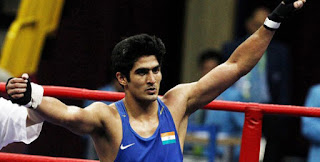IPL-style boxing league set to make impact in India
SOURCE : http://www.dawn.com
.
NEW DELHI: The Indian company which forked out $5 million for a World Series of Boxing (WSB) franchise has pledged its long-term commitment to the global amateur competition and is confident it can break even within seven years.
The Videocon Group set up the franchise last year but backed out citing “unavoidable circumstances”, and the inaugural season of the International Boxing Association (AIBA) event went ahead without Indian representation.
However, TransStadia chief executive Udit Sheth said his company had bought the franchise with definite long-term plans for the Mumbai-based team. “I won’t comment on why they (Videocon) pulled out but we are a sports company and we are in the business of sports infrastructure and sports IT management,” Sheth told Reuters in a telephone interview. “We felt it would be an ideal fit for our market. We bought the franchise for perpetuity… We are here for the long term, definitely.”
Sheth said his company would pump more funds into the project with the hope of breaking even by 2018. “We are paying almost $5 million to AIBA but at the same time we are also investing in our boxers, support staff, events, promotions…
“Over the next five years, we would be investing 500-600 million rupees ($11.16-13.39 million)…
“It will take five to seven years (to break even).” Sheth was convinced that boxing would garner enough interest in the world’s second most populous nation, where every sport is cricket’s poor cousin.
“India is an upcoming sports market. We definitely believe that with our success in international sports events, especially boxing, the market is ready to accept such sporting activities.
“That’s why we decided to bring WSB to India. WSB also has a major goal to enter the Indian market because of the large youth population in the country.
“We are convinced that boxing has a market in India. We would not have invested so much if we didn’t think it was a good venture to get into.”
CRICKET RE-RUNS
Sheth said they were also weighing up options on the best way to televise the event. “We and the AIBA are looking for the right partner. This is a great opportunity for the broadcasters as well to introduce new content.
“Currently, the only content which really works on TV in India is cricket and then you have re-runs of cricket and then more re-runs of cricket. I think this kind of new, live content would be welcome.”
The company was now in the process of recruiting boxers and support staff to prepare for WSB’s second season starting on Nov. 1.
“It’s like running a company. You need marketing guys, finance guys, technical guys…
“We will recruit 15 boxers and their sparring partners.There has to be some foreign competitors in every franchise as well.”
The tournament’s new competition format will have 12 teams divided into two inter-continental groups, facing each other on a home-and-away basis before the top four teams qualify for the playoffs.
Boxers in five categories trade punches in five-round bouts, without headguards or vests and using a professional-style scoring system.
SOURCE : http://www.dawn.com
.

